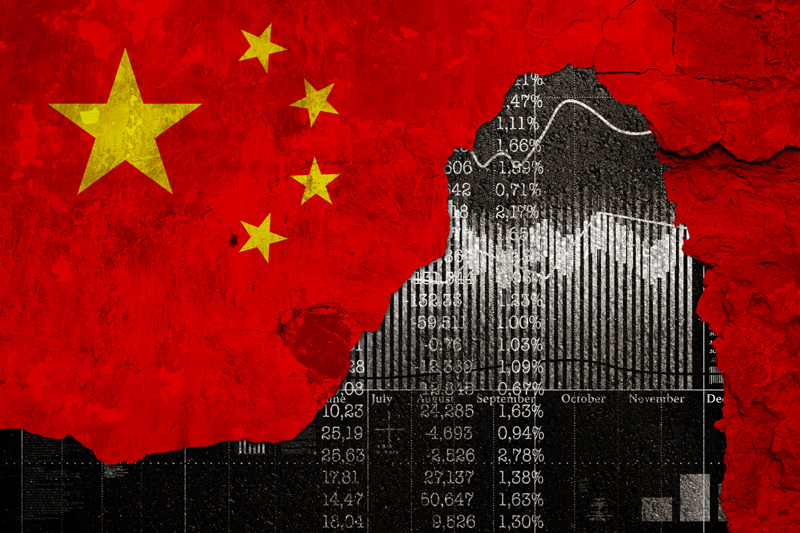One of the highest profile economic risks for the global economy is the pronounced slowdown in China. In order of severity, the key points of distress there are the property sector, debt levels, export weakness, a slowdown in domestic consumption, rising unemployment and poor demographics. We are closely monitoring the situation, as a meaningful decline in the world’s second largest economy could have a pronounced effect on global economic growth.
China’s property sector contributes roughly 30% of their GDP, and there has been a bubble forming for years, most visible in their infamous “ghost cities”. The bubble has sprung a leak, and the days of rampant property speculation in second or third homes, which served as a form of an ATM for the Chinese consumer, have been on the wane for the past three years. Almost two years ago the default of China Evergrande Group, then China’s largest developer, rocked the markets. The latest poster child for the collateral damage is China Garden, who replaced Evergrande as China’s largest real estate developer. According to China Real Estate Information, sales at the largest 100 developers are off 33% year-over-year through July, and China Garden’s were off a stunning 60%. The resulting cash crunch has caused them to miss two recent coupon payments and driven their debt to trade at roughly 25% of face value; a level firmly in “junk” status. China’s response to the weakness has been puny, with their most recent response to the situation being a 0.15% reduction in interest rates. The good news is that Chinese developers have been effectively shut out of global bond markets since 2021, so the damage should be largely isolated to China.
China’s growing debt burden is another reason for concern. Although Chinese data is notoriously doctored and often scant, researchers at JPMorgan Chase estimate a total debt-to-GDP level in China approaching 300% – higher than the 257% ratio in the U.S., yet a fraction of the +1000% level in deeply indebted Japan. As we learned during the Financial Crisis of 2008-2009, though, the combination of a property bubble and the debt market can be toxic, so the situation is serious.
China has been an export powerhouse since it gained membership in the World Trade Organization in 2001, and it has been the primary driver of China’s 6-8% annual economic growth prior to COVID. The lifting of lockdowns in Spring 2020 led to a goods buying binge by U.S. consumers, temporarily boosting the Chinese economy, but with the one-two punch of long COVID lockdowns in China, which put a brake on domestic consumption, and global consumers shifting towards services consumption, Chinese exports declined 14% in July in dollar terms, and economic growth has recently been closer to 3% than its 5% target for 2023 (and that is only if you believe the heavily massaged official statistics). In a nutshell, the government’s plan to shift from an export-led economy to more consumer-driven has hit a major speedbump.
All of the economic challenges that seem to have reached a crossroads at precisely the same time have manifested into an unemployment problem (a bit ironic for a Communist country). Although unemployment for the 25–59-year-old sector has remained stable at roughly 4% (again, assuming you trust the official statistics), youth unemployment for those aged 16-24 has nearly doubled over the past five years, reaching a high of 21.3% in June. In a tragi-comic twist, the Chinese policy response has been to no longer release the data!
The problem of youth unemployment is exacerbating the long-standing demographic problem of an aging and declining population in China; the younger generation is losing hope and is consciously avoiding having children. In addition, the population is skewed towards too many men and not enough potential brides, an unintended effect of the one-child policy implemented in 1980. As a result of these factors, the country’s fertility rate fell to 1.09 babies per a woman’s lifetime last year, which is well below the replacement rate. The authorities are acutely aware of the problem, and lifted the one-child policy in 2016. However, the situation is only worsening and the overall population has recently gone into decline. One need only look to the rapidly aging Japanese for an example of the growth constraints caused by demographic imbalance.
We are not discounting the severity of China’s problems but believe the impact on the global economy (and particularly the U.S. economy) will be muted. Chinese economic growth declined from a COVID-fueled 8.1% in 2021 to only 3% last year, yet the U.S. economy’s recovery has been barely affected. The U.S. simply does not export enough to China for weakness there to really move the needle – our total exports to China are roughly 0.6% of U.S. GDP. Due to lingering hostilities between the U.S. and China that figure is likely to decline on its own. According to The Economist, in the first half of 2023 U.S. trade with Mexico and Canada outpaced that with China for the first time in two decades.
Regarding a possible debt implosion, the bulk of Chinese debt is in the hands of its consumers and local governments. Their federal government has debt levels roughly 20% of ours and is sitting on reserves in excess of $3 trillion. This serves as a ammunition stash for a powerful policy response once they finally acknowledge the severity of the problem. President Xi Jinping is very wary of popular unrest and has reacted with a shotgun approach of a 31-point plan for enterprise, 20-point plan for consumption and a 26-point plan for labor.
We will continue to monitor the situation as it unfolds, which is likely to be a multi-year story. At present, though, we see a bit of an upside in the Chinese unrest; a slowdown in their economy and resulting deflation/currency devaluation should take further edge out of U.S. inflation and allow the Fed to ultimately end its rate hiking cycle. The biggest tail risk we see is that China responds haphazardly with a “wag the dog” response in the form of aggression towards Taiwan. Thankfully the odds appear low at present.
CCM Investment Advisers, LLC is a Registered Investment Adviser registered with the U.S. Securities and Exchange Commission (CRD# 105743). Any type of investing involves risk of loss and there are no guarantees that the strategies described on this website or any of the associated literature may be successful. The opinions and information contained in this report are for informational purposes only and are not meant to be predictors of future results. Such opinions and information do not constitute an offer or solicitation to provide investment advisory services. Such an offer can only be made in states where CCM Investment Advisers is registered.
Any type of investing involves risk of loss and there are no guarantees that the strategies described may be successful. Any performance data reported represents historical data and future returns may differ significantly. Past performance does not guarantee future results. CCM Investment Advisers does not assume liability for any loss which may result from the reliance by any person upon such information or opinions.
Security, index and economic information are obtained from resources which CCM believes to be accurate but no warrant is made to the accuracy or completeness of the information. Various indices described and discussed herein are unmanaged; investments cannot be made directly into an index.
The S&P 500 Index ® is a readily available, capitalization-weighted index of 500 stocks. The index is designed to measure performance of the broad domestic economy through changes in the aggregate market value of 500 stocks representing all major industries.
The S&P 500 Growth Index ® is a stock index administered by Standard & Poor’s-Dow Jones Indices. As its name suggests, the purpose of the index is to serve as a proxy for growth companies included in the S&P 500. The index identifies growth stocks using three factors: sales growth, the ratio of earnings change to price, and momentum.
The S&P 500 Value Index ® is a stock index administered by Standard & Poor’s-Dow Jones Indices. As its name suggests, the purpose of the index is to serve as a proxy for value companies included in the S&P 500. The index identifies growth stocks using three factors: the ratios of book value, earnings, and sales to price.
The Barclay’s Government/Credit Index is the non-securitized component of the U.S. Aggregate Index. The index includes US Treasuries, government-related issues and corporate bonds
The 50/50 Balanced Index is an index comprised of 50% S&P 500 stocks and 50% Barclay’s Government/Credit Index bonds.
The NASDAQ Composite Index is a readily available, capitalization-weighted index of over 2,500 domestic and international companies listed on the NASDAQ Stock Market.
The FANG+ Index is a equally-weighted index comprised of Meta, Apple, Amazon, Netflix, Microsoft, Alphabet, Tesla, NVIDIA, Snowflake and AMD. The index is rebalanced quarterly.
The UBS AI Winners basket tracks the performance of 40 US-listed stocks at the forefront of the Generative AI industry. Stock selection is based on input from UBS research analysts, specialty sales, and transcripts/reports. The basket has been optimized for liquidity with initial weights capped at 7% and trades $2.5bn in a day at 20% ADV.
All blended benchmarks are static blends.
Technical Terms:
The term federal funds rate refers to the target interest rate set by the Federal Open Market Committee (FOMC). This target is the rate at which commercial banks borrow and lend their excess reserves to each other overnight.
The Atlanta Fed GDPNow model is a real-time econometric model which forecasts GDP growth in the current quarter.
The Consumer Price Index (CPI) is a measure of the monthly change in prices paid by consumers. The CPI consists of a bundle of commonly purchased goods and services. The Bureau of Labor Statistics (BLS) calculates the CPI as a weighted average of prices for a basket of goods and services representative of aggregate U.S. consumer spending.
The term duration measures how long it takes, in years, for an investor to be repaid a bond’s price by the bond’s total cash flows. Duration can also measure the sensitivity of a bond’s or fixed income portfolio’s price to changes in interest rates.



